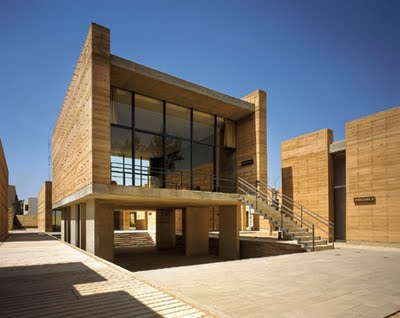Rammed Earth: Difference between revisions
Jump to navigation
Jump to search
(Created page with "*Nice overview - [http://webs.ashlandctc.org/jnapora/hum-faculty/syllabi/trad.html]") |
(mult. edits; inserted image) |
||
| Line 1: | Line 1: | ||
*Nice overview - [http://webs.ashlandctc.org/jnapora/hum-faculty/syllabi/trad.html] | [[File:CEB2.jpg|500px|thumb|right|Rammed earth at: Escuela de Artes Visuales de Oaxaca, Oaxaca, México.]] | ||
[https://en.wikipedia.org/wiki/Rammed_earth Rammed earth] is an ancient building method that has seen a revival in recent years. It produces noncombustible, thermally massive, strong, and durable buildings. However, walls can be labour-intensive to construct without machinery (powered tampers). Structures are susceptible to water damage if inadequately protected or maintained. | |||
Building a rammed-earth wall involves compressing a damp mixture of earth that has suitable proportions of sand, gravel and clay (sometimes with an added stabilizer) into an externally supported frame or mould. The construction of an entire wall begins with a temporary frame (formwork). | |||
==Links== | |||
* Nice overview - [http://webs.ashlandctc.org/jnapora/hum-faculty/syllabi/trad.html] | |||
* see: [[Earthco Megablock]] (not rammed earth but related) | |||
Revision as of 13:59, 16 July 2016
Rammed earth is an ancient building method that has seen a revival in recent years. It produces noncombustible, thermally massive, strong, and durable buildings. However, walls can be labour-intensive to construct without machinery (powered tampers). Structures are susceptible to water damage if inadequately protected or maintained.
Building a rammed-earth wall involves compressing a damp mixture of earth that has suitable proportions of sand, gravel and clay (sometimes with an added stabilizer) into an externally supported frame or mould. The construction of an entire wall begins with a temporary frame (formwork).
Links
- Nice overview - [1]
- see: Earthco Megablock (not rammed earth but related)
